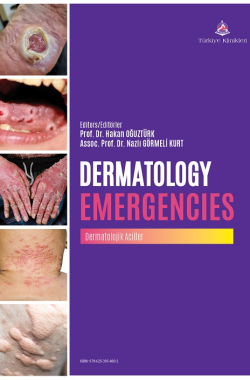Purpura Fulminans
Murat GENÇ
Ankara Training and Research Hospital, Clinic of Emergency Medicine, Ankara, Türkiye
Genç M. Purpura fulminans. In: Oğuztürk H, Görmeli Kurt N, eds. Dermatologic Emergencies. 1st ed. Ankara: Türkiye Klinikleri; 2025. p.52-4.
ABSTRACT
Purpura fulminans (PF) is a rare but life-threatening thrombotic and hemorrhagic disorder characterized by fever, shock, multiorgan failure and rapidly progressive hemorrhagic skin necrosis. It is often associated with serious infections, especially meningococcal sepsis, bacterial sepsis, autoimmune diseases and coagulation disorders. PF can be caused by hereditary or acquired protein C, S deficiency or activated protein C resistance. Dermal vascular thrombosis and disseminated intravascular coagulation (DIC) are associated with this condition. Neisseria meningitidis is the most common causative agent in pediatric patients, with S. pneumoniae and group A and B streptococci being other common pathogens. The clinical presentation is characterized by extensive ecchymoses, hemorrhagic bullae and skin necrosis. The purpuric lesions, which usually start in the extremities, spread over time and in severe cases necrosis and gangrene may develop in the distal extremities. Although the diagnosis of PF is based on clinical findings, DIC findings, prolonged coagulation times, thrombocytopenia and high D-dimer levels are typical in laboratory tests. Conditions such as warfarin-induced skin necrosis and catastrophic antiphospholipid syndrome should be considered in the differential diagnosis. Early diagnosis and intervention are vital in the treatment of PF. Treatment includes the use of broad-spectrum antibiotics with intensive supportive care. Since patients frequently develop septic shock and DIC, fluid therapy, mechanical ventilation and inotropic therapy, as well as surgical debridement for skin necrosis and amputation if necessary, may be applied.
Keywords: Purpura fulminans; skin disorders; necrosis
Kaynak Göster
Referanslar
- Brady WJ, Kumar Pandit AA, Sochor MR. Chapter 249. Generalized Skin Disorders. In: Tintinalli JE, Ma O, Yealy DM, Meckler GD, Stapczynski J, Cline DM, et al., eds. Tintinalli's Emergency Medicine: A Comprehensive Study Guide. 9th ed. McGraw-Hill Education; 2020. [Link]
- Hazelzet JA. Diagnosing meningococcemia as a cause of sepsis. Pediatr Crit Care Med. 2005;6(3):S50-S4. [Crossref] [PubMed]
- Gürgey A, Aytac S, Kanra G, Secmeer G, Ceyhan M, Altay C. Outcome in children with purpura fulminans: report on 16 patients. Am J Hematol. 2005;80(1):20-5. [Crossref] [PubMed]
- Chalmers E, Cooper P, Forman K, Grimley C, Khair K, Minford A, et al. Purpura fulminans: recognition, diagnosis and management. Arch Dis Child. 2011;96(11):1066-71. [Crossref] [PubMed]
- Edlich R, Cross CL, Dahlstrom JJ, Long III WB. Modern concepts of the diagnosis and treatment of purpura fulminans. J Environ Pathol Toxicol Oncol. 2008;27(3):191-6. [Crossref] [PubMed]
- Colling ME, Bendapudi PK. Purpura fulminans: mechanism and management of dysregulated hemostasis. Transfus Med Rev. 2018;32(2):69-76. [Crossref] [PubMed]
- Betrosian AP, Berlet T, Agarwal B. Purpura fulminans in sepsis. Am J Med Sci. 2006;332(6):339-45. [Crossref] [PubMed]
- Friedman MJ, Mendoza C. Petechiae and Purpura. In: Tenenbein M, Macias CG, Sharieff GQ, Yamamoto LG, Schafermeyer R, eds. Strange and Schafermeyer's Pediatric Emergency Medicine. 5th ed. McGraw-Hill Education; 2019. Accessed December 09, 2024. [Link]
- Festekjian A. Skin Signs of Systemic Disease. In: Tenenbein M, Macias CG, Sharieff GQ, Yamamoto LG, Schafermeyer R, eds. Strange and Schafermeyer's Pediatric Emergency Medicine. 5th ed. McGraw-Hill Education; 2019. Accessed December 09, 2024. [Link]

